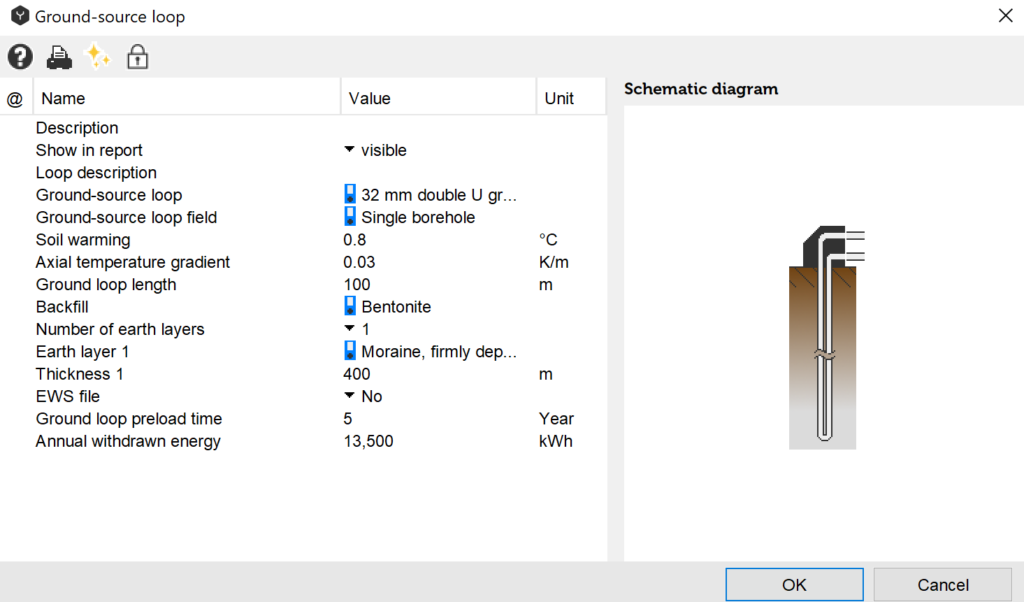Ground-Source Loops
Depending on output requirements and local conditions a ground-source loop can reach a depth in the range of 50 to over 100 metres. Three different types of ground-source loops (single-U, double-U and coaxial) are typically lowered into the borehole. The mathematical model that Polysun uses for ground-source loops was imported from the EWS programme.
Compatibility with the EWS programme makes it possible from user level Designer and above to enter EWS project files directly into Polysun. The strong model running in the background makes it likewise possible to set-up ground-source loop fields. These are characterised by indicating Eskilson’s g function:
\(g = (r,t)\frac{\mathrm{\Delta}T_{Erde}(r,t)2\pi\lambda_{Erde}}{\dot{q}}\)
\(\Delta T_{Erde}\) = Temperaturabsenkung
\(\lambda_{Erde}\) = Wärmeleitfähigkeit
\(\dot{q}\) = spezifische Entzugsleistung
This dimension-free step response reproduces the temperature behaviour within the ground-source loop environment with respect to the uninfluenced ground. Care should be taken that the g-function always only applies to a determined ratio between loop depth H and loop distance B. A wide range of ground-source loop arrangements is available in a separate catalog. The B/H ratio does not necessarily have to match the actual arrangement as an effective B/H ratio will be extrapolated in case of any deviations. So as to keep extrapolation inaccuracies to a minimum the closest possible ratio should always be used.
The model admits a maximum of up to 10 different earth layers each of which will affect the calculation of the ground-source loop as a whole. Multiple temperature nodes will be calculated for each earth layer according to a detailed physical model. The model also takes into account a possible energy rear feed, for example, for regeneration or free-cooling purposes.
To effectively simulate the degradation of the loop a “Annual withdrawn energy“ and a “Loop pre-load time“ may also be entered. In doing so the ground-source loop will be preloaded with a constant load over the given length of time. Should the ground-source loop behaviour be calculated in the long term, preliminary simulation duration may be appropriately set (in menu under System diagram – Preliminary simulation). This preliminary simulation enables the whole of the system to be simulated so that the actually arising workload may be applied to the ground-source loop. If 50 years are to be simulated the value to be entered is 17885 (49 * 365), i.e. 49 years are pre-simulated before the standard annual simulation is carried out.
Soil heating defines the difference between the average annual temperature of air and soil surface. Typical values are as follows:
- Forest, shady location: 0 K
- Field, meadow: 0.8 K
- Average value: 1.5 K
- Urban location up to 2 K
- Snow-covered elevation: up to 4 K
The axial temperature gradient defines temperature increase with depth. Such gradient is defined as the soil’s geothermal heat flow/heat conductance. A typical value is 0.03K/m (0.06W/m2 / 2 W/mK).

During the simulation Polysun calls up the relevant ground-source loop algorithm each 4 minutes producing thus consistently reliable end results.
For a detailed description of a ground-source loop see the publication issued by Hetag AG in 1997: